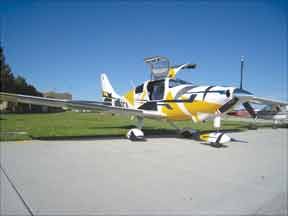No one could blame the Cessna TTX for having a bit of an identity crisis. This latest iteration is the fourth name change for the aircraft (and is technically written TTX). It also bears a striking resemblance to the Cirrus SR aircraft, which outnumber it better than 10 to one.
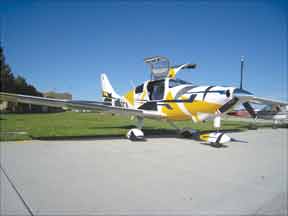
Today’s TTX started life as the Columbia. This was a certified aircraft from kit company Lancair, whose fiberglass aerial hotrods topped 300 knots on a like quantity of horsepower with wings the size of boogie boards. The Columbia leveraged that expertise, but was a clean-sheet design. The final results were impressive: Terrific low-speed handling with a 59-knot Vso while still topping 200 knots at altitude, and impressive crashworthiness (see www.niar.wichita.edu/agate/ and scroll down to the videos).
But the Columbia remained a niche aircraft while the well-marketed and parachute-equipped Cirrus changed the face of general aviation. In 2007, Cessna bought the Columbia aircraft company out of bankruptcy. They tweaked and rebranded the aircraft a few times, but never posed a serious threat to Cirrus’ dominance in this market segment.
Scroll the timeline to Sun ‘N Fun 2011 and Cessna announces the TTX, with the big-ticket item being the first OEM sporting the G2000 avionics suite, dubbed Intrinzic by Cessna. Unfortunately, they also moved some production from Bend, Oregon, to Mexico in this period and then had a wing partially delaminate on a production flight test.
Cessna halted production, bought back and crushed all the existing Mexican airframes, and dug deep to find the problem. It appears to have been a freak event, but it’s the primary reason the TTX has been so long in fruition.
New Stuff
Cessna has made the most of the extra time in polishing the TTX design and options. The new $733,950 airplane will have airbags standard. Gear fairings that once made a low-frequency rumble have been changed, and there are more interior and paint options. What was an aftermarket oil-cooling improvement is now standard. Air conditioning is standard, but can be removed to shave off 69 pounds and $10,300.
An inadvertent icing system with TKS wings and an electric prop has long been a $25,700 (and 36-pound) option, but the TTX can be had with a flight into known icing (FIKI) system for $49,500 (and about 50 pounds). Neither of these weights include the de-ice fluid, which is 10 gallons for about two hours of protection on the FIKI. The TTX will offer Iridium in the cockpit for worldwide weather and communication.
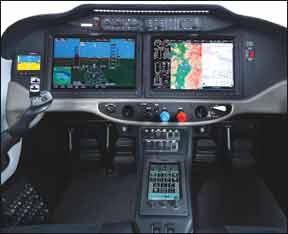
Cessna told us they are actively exploring other engine options “from any vendor or for any fuel.” But there are none yet that match the performance of the Continental TSIO-550. They also described a few improvements in the pipeline that will come out later this year or early next, for both the airframe and the Intrinzic, that aren’t ready for public consumption. Suffice it to say that what we consider a good airplane is progressively getting better.
Head Turner
No matter what name the airframe has sported, it’s always been a standout on the ramp. Differentiating it from the similar Cirrus is a slightly more rakish look and a sharper angle to the tail. Its cabin doors open gull-wing style, with a slightly higher sill that the Cirrus and slightly more restricted access to the rear seats.
Taking Cessna at its word that there are no lingering issues with Mexican parts production, the composite work on the TTX is still top-tier. All the control surfaces are composite as well. TTX buyers can work with paint designers for personalized paint schemes. We weren’t exactly enthralled with the paint scheme of the demonstrator we flew, but it does make the aircraft stand out.
The TTX Has a Tangible Beefiness
about it, with two locks on the baggage door and a positive closure to the gullwing cabin doors. Inflatable doorseals significantly cut cabin noise, but you’ll still want a noise-cancelling headset. Elevator and ailerons are controlled by a side-stick moving pushrods rather than cables. The result is butter-smooth, backlash-free control that responds to even slight inputs.
Front seats have ample room and a wide range of adjustment for pilot size. The rear seats have good forward visibility, but less headroom than a Cirrus. The 120-pound baggage area has great access, but it’s slightly smaller than the Cirrus, and the lack of a rear window makes the baggage and rear seat area darker.
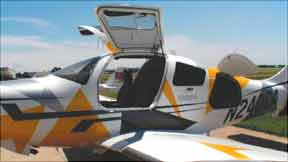
Flying It
Startup for the 310-HP Continental TSIO-550-C is conventional. Overhead master switches give that big-airplane feel, but most hard switches sit between the power controls and the touchscreen controller that drives the Intrinzic system. The environmental controls, four-place oxygen system, and several other system have no hard switches. They are controlled via the pedestal-mounted touchscreen between the front seats. That single touchscreen is also the heart of the Intrinzic flight deck whose two screens dominate the TTX panel. The Intrinzic warrants its own section on pages 7-8.
Taxi is what you’d expect with a free-castering nosewheel. You won’t need brakes so long as you taxi a bit faster than the FAA-recommended fast walk. Takeoff has two small quirks: The big Continental will bog down for a moment if you advance the throttle too rapidly, and the TTX won’t abide by feet-on-the-floor climbs.
Instead of rudder trim, the TTX has a rudder-hold switch. Slightly overcorrecting with rudder, engaging the hold, and then putting your feet on the floor results in a coordinated climb. Just remember to get your feet back on the pedals to ease off the rudder when transition to cruise or you’ll enjoy a nice fishtail when you turn off the switch. There is no option for a yaw damper.
We saw 1450 FPM off the runway on a hot day at mid weight. That settled down to about 1250 climbing at 110 knots, and was still a respectable 750 FPM by 13,500 feet. Bragging rights go to the TTX for 235 knots at 25,000 feet, but real-world numbers that you’re more likely to see are 185 knots cruise below 10,000 feet, the 190s in the mid-teens and the low 200s in the flight levels. This is essentially on par with a Cirrus SR22T.
Our demo plane didn’t have oxygen available, so we could only test up to 13,000 feet where we saw 196 knots true at 3 degrees C and 23.5 GPH running rich of peak. Cessna is reworking the TTX’s manuals to allow lean-of-peak ops up to 85-percent power. This saved us 7 GPH at the price of 10 knots—well worth it, in our view.
The TTX gives you about 1000 pounds of useful load to play with, 612 pounds of which could be fuel (102 gallons, which is 10 more than a new Cirrus). You could make a short flight with four big people or go far with two and bags. Economy range tops 1200 miles, but 900 is more realistic with a high-power, LOP cruise and 45-minute reserve.
In a word, the TTX’s handling is superb. Control feel is crisp due to the pushrods. Roll rates are sporty enough to be enjoyable without sacrificing stability. Control harmony is excellent, and low-speed control authority is terrific. Stalls are a minor event. We think the TTX is easier to trim precisely than the Cirrus, however, when accidently perturbed in pitch it takes longer to work its way back to the trimmed speed.
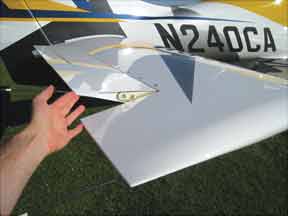
Pilots transitioning to high-altitude airplanes are often surprised how light the controls become at 25,000 feet. If the controls aren’t light at altitude, they’re likely heavy at high speed and low altitude. This is the case with the TTX. While aileron and elevator felt just right at pattern speeds and in cruise in the teens, they’re noticeably heavy by the bottom of a 180-knot descent. Standard speed brakes offer a bonus 500 FPM down without picking up speed as an alternative.
As we said, the TTX controls feel perfect at pattern and approach speeds. Crosswind authority feels good, although we didn’t have an opportunity to really press it. Gross weight landing distance is published at 2640 feet over an obstacle with 1280 feet of that as ground roll. After two easy landings, we would have taken the TTX into any decent runway of 3000 feet. Shorter would be reasonable with precision, especially at less than gross weight.
Autopilot controls are just under the glareshield, as you’ll find on Cessna jets, and we think Garmin’s GFC 700 autopilot coupled with their digital servos set the bar for a light-aircraft autopilot. The Intrinzic’s flight planning allows sophisticated vertical management, including custom crossing altitudes, as we’ll as unpublished holds. If you want to fly hands off from just after rotation to just before the flare, you could probably do in adjusting little more than the flight plan as you went.
Like its Garmin-powered Cirrus rival, the TTX includes Garmin’s stability protection and coupled go around. The former is a system that’s active when the autopilot is off. Bank over 45 degrees and the autopilot servos will coax the aircraft back toward 30 degrees of bank. Overspeeds and underspeeds are likewise protected.
A button just above the throttle activates go-around mode. Push it as you add power, and the autopilot will pitch up to climb without disconnecting while the Intrinzic sequences for the missed approach. If you forget to add power the aircraft will still pitch up, but only enough to hold minimum speed while it squawks at you to do something about the problem.
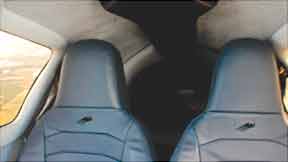
What’s notably lacking in the Cessna version of this autopilot, however, is the one-button recovery to straight-and-level. Tarreld Shriner, business leader for the TTX, told us this was by design and foretells of autopilot capability down the line that, “will do far, far more than just level the wings.”
We find this answer lacking. A hinted-at autoland capability has fascinating potential, but emergency attitude recovery is clearly available today. The TTX is already one-down in many prospective buyers’ eyes because it lacks an airframe parachute. Emergency attitude recovery might mitigate that for some. Shriner tells us that the current TTX has the avionics and mechanicals to be upgraded when (or if) the uber-autopilot becomes a reality.
TTX or SR22T?
We think Cessna has the TTX’s role in long-term customer loyalty just right. The TXX is a realistic leap for a competent Cessna 172 pilot, so long as they get good instruction. New TTXs come with 12 hours of transition training. Moving straight from a TTX to a light jet should be a reasonable reach as well.
But the more pertinent question for wider sales is whether the TTX is a better buy than a Cirrus SR22T. We originally had a comparison chart, but the book values for capacity and performance of the two airplanes were too similar. Granted, top speed for the TTX is 11 knots faster, but at realistic altitudes and power settings, we believe the difference is less.
The G2000-based Intrinzic has serious appeal. Cirrus still offers its G1000-based Perspective avionics suite. But given the avionics arms race, we don’t expect this distinction will exist much longer.
Comparing prices is somewhat unfair because of the avionics difference, but the difference significant. As evenly equipped as we can make them, a non-FIKI Cirrus SR22T GTS is $712,600 while the equivalent Cessna TTX would be $772,925—a $60,000 difference. For FIKI versions, the delta drops to $50,000. But as we said, this comparison is unfair because the TTX flight deck is really a generation ahead of the Cirrus.
No matter how we’ll equipped, or with what bold paint scheme, turning the lesser-known TTX into a real contender against the popular kid from Duluth will be tough. Even Wichita Approach was confused as to what we were flying on the demo ride. We bet they’d know a Cirrus.
However, the right buyers should recognize the Cessna TTX for what it is: a fantastic traveling airplane with an avionics suite that, for the moment, is second to none.

